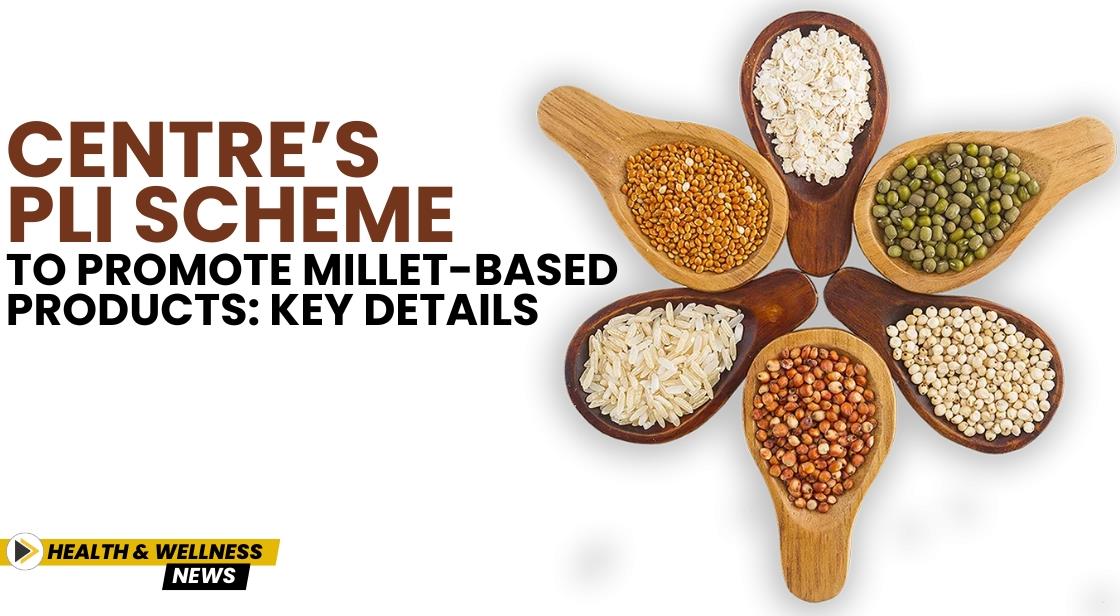Centre’s PLI Scheme to Promote Millet-Based Products: Key Details

News Synopsis
In a move to bolster millet-based food production and processing, the Government of India has introduced the Production Linked Incentive Scheme for Millet-Based Products (PLISMBP).
This five-year scheme, running from 2022 to 2027, is a significant step toward supporting millet farmers and encouraging the integration of millets in consumer food products.
With an allocation of ₹800 crore, the scheme aims to foster innovation in millet processing, value addition, and product development. By removing the threshold investment requirement, it has been designed to accommodate a broader range of participants, making it accessible to small and medium enterprises.
Key Features of the PLI Scheme
-
Incentive Eligibility: Companies can avail of incentives by achieving a minimum 10% year-on-year sales growth over the base year.
-
Product Criteria: The focus is on branded Ready-to-Eat (RTE) and Ready-to-Cook (RTC) products containing at least 15% millet by weight or volume, packaged for direct consumer use.
-
Domestic Sourcing: To support Indian farmers, products under the scheme must use domestically sourced agricultural ingredients, excluding additives, flavors, and oils.
Beneficiary Status and Impact
Initially, 30 beneficiaries were selected under the scheme. Following the withdrawal of one participant, 29 companies continue to participate. This effort has strengthened local agricultural procurement, bringing direct benefits to farmers engaged in millet cultivation.
For the first performance year (FY 2022-2023), 19 participants filed claims in FY 2023-2024, resulting in the disbursement of ₹3.917 crore to eligible applicants.
Government Initiatives for Smooth Implementation
The government has prioritized the efficient execution of the scheme by:
-
Launching a user-friendly portal for easy access to information.
-
Establishing support groups for resolving issues faced by participants.
-
Organizing weekly meetings to track progress and address challenges.
-
Offering technical support and issuing clarifications on guidelines.
These measures are expected to build trust among stakeholders and ensure the scheme's long-term success.
Why Focus on Millets?
Millets, often referred to as "super grains," are gaining global recognition for their nutritional value and resilience to climate change. India, being the largest producer of millets, has a golden opportunity to lead the way in promoting these grains as a healthy alternative.
The United Nations has declared 2023 as the International Year of Millets (IYM), amplifying the focus on millets and creating an international market for these products. The PLISMBP aligns with these efforts by promoting millet-based RTE and RTC products, contributing to both domestic and global food security.
The Road Ahead
The PLI scheme for millet-based products is not just an economic initiative but also a means to address nutrition, sustainability, and rural development. By fostering innovation in millet processing and encouraging farmers, the government aims to elevate India's position in the global millet market while ensuring better income for farmers and healthier food options for consumers.
What Are Millets?
Millets are a group of small-seeded, nutrient-rich, and climate-resilient grains that have been cultivated for thousands of years as a staple food in many parts of the world. Known for their adaptability to arid and semi-arid regions, millets are an essential crop for sustainable agriculture and food security.
Types of Millets
Millets can be categorized into major millets and minor millets, depending on their global importance:
-
Major Millets:
-
Sorghum (Jowar)
-
Pearl Millet (Bajra)
-
Finger Millet (Ragi)
-
-
Minor Millets:
-
Foxtail Millet (Kangni)
-
Proso Millet (Chena)
-
Barnyard Millet (Sanwa)
-
Kodo Millet
-
Little Millet (Kutki)
-
Nutritional Benefits of Millets
Millets are often referred to as "super grains" due to their high nutritional value. They are:
-
Rich in fiber: Promotes digestive health.
-
High in protein: Provides essential amino acids.
-
Gluten-free: Suitable for individuals with gluten intolerance or celiac disease.
-
Packed with micronutrients: Such as iron, calcium, magnesium, and B vitamins.
Health Benefits of Millets
-
Helps Manage Diabetes: Low glycemic index keeps blood sugar levels stable.
-
Aids Weight Loss: Fiber content keeps you full for longer.
-
Supports Heart Health: Reduces bad cholesterol and promotes cardiovascular health.
-
Improves Immunity: Rich in antioxidants.
Millets and Sustainability
Millets are often hailed as "climate-smart crops" because:
-
They grow in poor soil conditions with minimal water and fertilizers.
-
They have a short growing cycle, making them ideal for regions with unpredictable rainfall.
-
They contribute to environmental sustainability by improving soil fertility and reducing carbon footprints.
Millets in India
India is the largest producer and consumer of millets, which have been a traditional food in the country for centuries. To promote their benefits, the Indian government has taken initiatives such as declaring 2023 as the International Year of Millets (IYM) in collaboration with the United Nations.
Culinary Uses
Millets can be used in various forms:
-
Flours: To make rotis, bread, and cookies.
-
Whole grains: Used in porridge, salads, or pilafs.
-
Processed products: Such as breakfast cereals, energy bars, and ready-to-eat meals.
Millets are not just a food crop; they represent a sustainable and healthy future for global agriculture and nutrition.
You May Like









